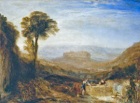



It is best to visit Orvieto at the beginning or end of a trip to Umbria, making the most of its excellent rail links to Florence and Rome. The station is at the foot of the cliff on which the city is perched, and a funicular railway takes you up to the point of departure for the frequent bus service to the city centre. (It is, in fact, easy to walk from the funicular exit to the centre if you are not carrying heavy bags).
Orvieto is not particularly easy to reach from other Umbrian cities. You can arrive by train from Perugia (by changing at Terontola) or from Foligno and other stations on the Rome-Ancona line (by changing at Orte). There are also bus links to Terni, Narni, Todi and Amelia (by ATC - scroll down for intercity services), although buses do not run on Sundays and holidays.
A Bit of History
Orvieto, on the border of Umbria and Tuscany, stands on top of a tufa cliff that historically provided impenetrable defences. They did not keep out the Romans, who sacked the Etruscan city in 265 BC and moved its population to the shores of Lake Bolsena. The memory of the vibrant culture that the Romans destroyed can be seen in the three archeological museums of Orvieto, on the site of the Etruscan Tempio del Belvedere and at the necropolis of Crocifisso del Tufo at the foot of the cliff.
The original city came back to life in the 5th century and provided refuge for the Ostrogoth general Witiges when the Byzantine Belisarius drove him from Rome in 539 AD. Belisarius managed to starve the garrison into submission, but this was the last time that Orvieto fell to an enemy without treachery from within.
A series of popes took refuge here in the 13th century, attracted by the city's relative safety and also by its white wine (now called Orvieto Classico). This stimulated the development of an important artistic culture. Orvieto's most famous monument is the Duomo, which boasts a magnificent facade that was begun at this time. Unlike those of Florence and Siena, this one was actually completed - although it took some 300 years.
The artistic culture of Orvieto declined in the Renaissance and little of note from this period survives. The notable exception is the fresco cycle (1501-4) by Luca Signorelli in the Cappella Nuova of the Duomo, which probably inspired Michelangelo's Last Judgement in the Sistine Chapel.
Pope Clement VII took refuge at Orvieto for a few months after the sack of Rome in 1527, and he found the city in a very depressed state. However, it revived in the following decades, both economically and artistically, under the patronage of families that grew rich at the papal court in Rome.
Hotels and Restaurants
I cannot do justice here to the surprising number of good hotels and restaurants in Orvieto. However, I can recommend two very nice hotels near the Duomo:
-
✴Hotel Duomo; and
I also liked Hotel Piccolomini.
Two B&B establishments look enticing:
-
✴B&B Ripa Medici; and
Like most people, I love Trattoria la Palomba, 16 Via Cipriano Manente. Among my other favourite restaurants in Orvieto are:
-
✴I Sette Consoli, which has the bonus of a lovely garden.
-
✴Ristorante Piazza del Popolo, 3 Piazza del Popolo; and
-
✴two restaurants in Piazza del Duomo:
-
•I Giglio d’ Oro; and
I also enjoyed:
-
✴Le Grotte del Funaro, 41 Via Ripa Serancia;
-
✴Locanda del Lupo, which also offers B&B; and
-
✴Trattoria al Corsica, Piazza Angelo da Orvieto.
Wherever you eat, you are sure to find a good selection of wines with the appellation Orvieto Classico.
Good places for lunch include:
-
✴two in Piazza del Duomo:
-
•Cantina Foresi, at number 2; and
-
•Enoteca Tozzi, at number 13 (where you can order a porchetta sandwich and a "glass" of wine in a paper cup to eat on the terrace outside);
-
✴two in Corso Cavour
-
•Caffè Montanucci; and
-
•Caffè ClanDestino; and
-
✴Ristorante al San Francesco in the ex-convent of San Franceso.
My usual breakfast spots are:
-
✴Caffè del Corso, Corso Cavour (at the junction with Piazza Sant’ Angelo);
-
✴Caffè Cavour, 74 Corso Cavour; and
-
✴Blue Bar, 23 Via Garibaldi.
All three have free Wi-Fi.
Return to the page on Cities of Umbria.

